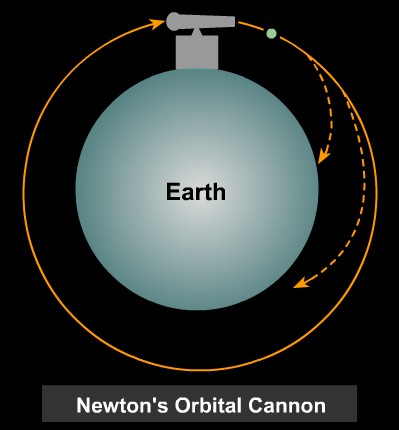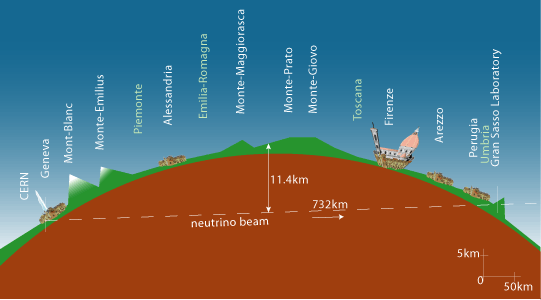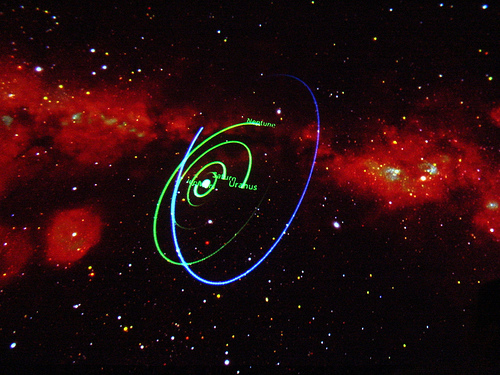"You still don't get it, do you? He'll find her! That's what he does! That's ALL he does! You can't stop him!" -Kyle Reese, the Terminator
Now that we've all survived Judgment Day, we can stop looking for ways to stop the Terminators, and go back to the search for dark matter. Let's back up a bit, though, and take a look at normal matter first.

As you well know, normal matter here on Earth is always subjected to the force of gravity. You throw something up into the air, and the Earth's gravity always works to pull it back down. In general, something moving under only the influence of the Earth's gravity will make a parabolic shape, like the motorcycle above.
But is that really what's going on? After all, if I launched this motorcycle fast enough, it wouldn't make a parabola at all. Perhaps, if I even gave it a big enough starting speed, I could put it into orbit around the Earth!

And this, of course, is true. It's basically what we do to get satellites, shuttles and space telescopes into orbit around the Earth. And -- just like the Moon -- they obey the laws of gravity too, and orbit about the Earth in an elliptical shape.
But what about those trajectories that don't make it off of Earth? Are they somehow, fundamentally, any different? The (perhaps surprising) answer is no! What you see as a parabola is really just one small part of a giant ellipse, centered on the Earth!

Of course, if you're made out of normal matter, you don't complete the ellipse: the Earth is in the way! And normal matter like you, as you may have noticed, doesn't pass through the Earth so easily. It doesn't pass through any normal matter easily, in fact, as you may have noticed. If you take your thumb and press down on any normal matter, like in this fingerpaint turkey below,

you'll find that there's something stopping your finger from simply passing through to the other side. There is, of course, a very fundamental physics reason behind this. If I go all the way down to the atomic level, I find, for any type of solid matter, the following type of structure.

In other words, matter is made up of atoms. And you know what happens when you bring two different things together: the atoms push back against one another, and don't allow you to simply pass one through the other. Practically, atoms take up a finite amount of space. Fundamentally, your atomic nature is why you don't fall through the Earth when you stand. Gravity would love to pull you down towards the center of the Earth, but the force of the atoms on the ground push back on the atoms on the soles of your feet, keeping you from falling.
The force behind it is electromagnetism, and along with gravity and the two types of nuclear forces, they make up the fundamental interactions of nature.

Atoms, of course, are subject to all four of these forces. Gravity, perhaps, is just the most common one that we talk about. But not all types of matter feel all four of these interactions. Take, for instance, the neutrino. We can take a neutrino and shoot it through hundreds, thousands, or even millions (if we had millions) of kilometers of solid matter, like we do all the time!

Why can we do that? Because neutrinos only interact gravitationally and through the weak force. They have no electromagnetic interactions (because they're electrically neutral) and they have no strong nuclear interactions. In fact, the only reason we can detect them at all is because of the weak force. Despite its name, the weak force is some 1025 times stronger than gravity is. If you want to detect a neutrino, you need to build a huge tank full of stuff for neutrinos to interact with...
...and a huge number of neutrinos in order for you to have a chance to just see a few.
Now, neutrinos -- as elusive as they are -- can not be the dark matter we see in our Universe, because they interact too much! That's right, whatever dark matter is, it interacts gravitationally, and less strongly in every other way than all known particles in the Universe.
Which explains why it's so hard to find! In other words, if you had a dark matter particle that you threw up into the air (somehow), its path would look like this:

In other words, it would simply pass through the Earth, because it doesn't interact by the strong, electromagnetic, or weak forces, as far as we can tell. Which is maddening, because we want to be able to find it!
But we make our best models for a galaxy, and what do we find?
That the dark matter exists in a huge, diffuse halo around the galaxy. Because it isn't made out of atoms, it doesn't "collide" in the conventional sense. It simply falls freely under the influence of gravity, and takes the plunge in these giant elliptical paths, undaunted by all the stars, planets, gas, dust, etc., in its way.
It also doesn't collide with itself! If we were to take two of these giant dark matter halos and try to smash them into each other, know what would happen?
They'd simply pass through one another. Which is great for astrophysics, because it aligns with what we see in an entirely consistent way. But which is lousy for dark matter hunters, because it makes the stuff incredibly difficult to detect directly!
And in the meantime, you realize, the Earth is orbiting the Sun, which is spinning around the galaxy, which is filled with dark matter.

Do we have a chance at detecting it? Well, yes, of course we do. All we need to do is build a detector -- in principle -- that's sensitive to it. And there are a few groups looking for it in different ways. There are groups like CDMS and Xenon (shown below), which are trying to detect a collision between dark matter and normal matter directly.
These groups don't see anything, and are placing tighter and tighter constraints on what dark matter could be. There are also groups looking for any general sort of thing, like DAMA or COGENT, and looking for differences between the times of year where the Earth is moving faster through the galaxy and slower through the galaxy.
As reported, these groups see stuff! Well, they see differences, anyway. But is what they're seeing dark matter, or is it something different? They don't know; at this point, either explanation works. What we do know is that direct detection experiments and attempts to create these particles using accelerators has failed so far.
It could be dark matter, of course. And if it is, all we have to do is figure out a way to create it in the lab and we'll have solved our great dark matter mystery! But if this "annual modulation signal" is due to anything else, such as an asymmetry in emitted particles from the Sun, a modulation in zodiacal background, or anything else that involves "normal" matter, then we are fooling ourselves by looking for dark matter in this fashion.
It's very exciting for the teams that are seeing something, but they've got a long way to go to demonstrate that it's actually dark matter, rather than something much more mundane. Here's hoping, though!





Fascinating. It's stuff like this that keeps me awake at night.
Can you list some of the conventional innovations that can result upon the discovery of dark matter?... Also could properties of black holes allow a inter-dimensional passage?
Well, to answer the title question:
a) It matters.
b) It doesn't matter.
c) Both of the above.
But more seriously, has any of the observations of dark matter constrained whether it seems to have normal matter's 1:1 inertial mass to gravitational mass ratio? If it were otherwise, would the 20% or so figure for how much of the universe is dark matter mean the gravitational mass? That's what I would expect.
I don't think your diagram of a dark matter particle through the earth can be correct. At periapsis (the lowest point of an orbit) in a normal, outside-the-earth orbit, an object is moving its fastest, and is undergoing the most gravitational acceleration because it's so close to the gravity source. It's that increased gravity that whips it around back in the direction from which it came.
But when the orbital path dips below the surface of the earth, you can no longer treat the earth as a point source of gravity centered in the earth's core. There's now matter above you, pulling back with its gravity. At the exact center of mass of the earth, you'd feel no gravitational force at all, because the gravitational pull is the same in all directions. So when this fast-moving dark matter particle gets there, there's no force to make it change directions.
So instead of gaining speed toward the center, and then whipping back around to where you tossed it from, the dark matter particle would keep right on going past the center of the earth. I don't know how to do the math on this, but I would assume the shape would be more of an ellipse *centered* on the center of the earth, rather than an ellipse with the earth's center at one focus.
I have been working on an idea for a long time that gravity has mass.
So the idea that dark matter is actually gravity fits.
This goes on further that when the gravity increases the velocity of light decreases just as it does in denser materials( optical refraction).
This then let's frame drag explain the rapid expansion phase of the big bang.
If we put electrons in their orbit under the same rules due to gravitational density limiting speed we get the time dilation of relativity and the gravitational lending of warping space time can revert back to neutonian density lensing.
I do not know enough math to prove or disprove this but it seems a way to resolve neutonian and relativistic physics and explain dark matter at the same time.
Today, I learned that the same person who can explain Einstein and other great stuff to thousands of people and has a university education in math, physics, and astronomy, also believes that a parabola can be a part of an ellipse. Ethan, a parabola involves an equation with two variables, one of which is squared, and in an ellipse, both variables are squared. If alligned on the same axis, as in your drawing, a parabolla can intersect an ellipse at 0, 1, 2, or 4 points at the most - but there is never a part where they both follow the same path (a "path" being a part of the curve longer than a single point)! This is high school calculus - I am sure you know that.
Other than that, interesting article about the dark matter research and a great blog in general - please keep writing!
But that's not what he said!
"What you see as a parabola is really just one small part of a giant ellipse, centered on the Earth! "
Note the word "see". If one can only measure a very small part of a conic section near its apex then its very difficult to distinguish an ellipse, a parabola or an hyperbola. (I think your comment about squared variables is also misleading - that only applies if you take cartesian coordinates aligned with the axes. Nor is calculus relevant. Conic sections have been well understood since long before calculus or cartesian geometry was invented.)
@Sadie C. #4: Very close, but. When you're within a radially symmetrical (I think that's the right term for this kind of symmetry?) body, it works out so that you can treat it as a point source of the mass of everything closer to the center than you, and ignore everything further out. The mass pulling from overhead is exactly canceled by the greater but more distant mass on the other side and further out than yourself.
So, your point does hold true, that it wouldn't be an ellipse within the Earth. Just a minor nuance.
@Ethan:
That the dark matter exists in a huge, diffuse halo around the galaxy. Because it isn't made out of atoms, it doesn't "collide" in the conventional sense. It simply falls freely under the influence of gravity, and takes the plunge in these giant elliptical paths, undaunted by all the stars, planets, gas, dust, etc., in its way.
You left something out from the above list. What if an Invisible DM particle tries to pass through a black hole on its elliptical journey?
Note: Iâve seen several articles claiming that Invisible DM is not associated with black holes. Do you know of any that claim otherwise?
What do you mean by "associated with"?
Black holes aren't dark matter, if that's what you mean. Dark matter is nowhere near granular enough for that to be possible, there are no jets, and there's no Hawking radiation.
I mean, and the articles meant or implied, irrestibly "attracted to", of course.
I'm fully aware that Invisible DM is not baryonic matter nor is it related to black holes.
One of the first "observations" of dark matter was done by Fritz Zwicky, a Swiss astrophysicist. In 1933 Zwicky was studying the motions of faraway galaxies. At first Zwicky estimated the mass of the observed galaxies by measuring their brightness. http://www.transtutors.com
Dark Matter
The reason that Dark Matter
Isn't very bright
Is possibly it's travelling
Much faster than the light
Egal Bohen
Is possibly travelling much faster than the light.
Well, no. First, there's no need to invoke such a property. Neutrinos are almost as indetectable as DM (ie. impervious to matter interactions). Why should DM be any different? The one difference with DM, as Ethan notes, is that neutrinos do interact with matter via the weak force. Second, it doesn't help explain the lack of interaction of DM with matter. Why would 'faster than light' velocity in and of itself prevent interactions with matter? You still need a separate cause for that, which does not require such a property in the first place, cf. neutrinos.
What I'm confused about is whether a 'particle' of DM is required to occupy a point X in space that no other particle (DM or otherwise) can occupy. If DM is totally immune to the three non-gravitational forces, wouldn't it be essentially dimensionless?
Re #4 & #8; I think Sadie is correct about the diagram.
Think about a gravity train. This is the same as our dark matter particle except the elipse has been squashed into a straght line because the train starts with zero horizontal velocity.
This is the clearest explanation of the dark matter hypothesis that I have ever read!!
Referring to the image of two dark matter halos colliding: How would the collision of two neutrino clouds interact differently? Also, any thoughts on how/why a dark matter particle might be able to avoid colliding with another dark matter particles? Thanks.
Alan, Sadie
This is a teaching model, not an exact model. Nitpicking aside Ethan is correct; the orbit is aapproximately an ellipse.
But yes, the effective gravitational force emanating from the ellipse focal point (i.e. center of Earth) is cyclically changing, similar to gravity train.
Thus in a carefull calculation, I would envision the dark matter orbit distorting from an ellipse into an egg or more complex orbital pattern.
Neat stuff... you mentioned a couple of teams tackling this mystery but nothing on how this Alpha Magnetic Spectrometer (AMS) which is about to launch will do?
I have a question. Any idea what keeps the DM from collapsing to the center, if it interacts only gravitationally?
Peter: Inertia keeps DM from collapsing to the center. Remember, DM doesn't feel ordinary matter so it thinks it's just traveling through empty space. So it just keeps orbiting massive bodies the way the planets orbit the Sun.
RE OkThen @18. Nobody is disputing Ethan's considerable talents or arguing against eliptical orbits, Sadie simply and politely pointed out the diagram is wrong.
I have a question. Any idea what keeps the DM from collapsing to the center, if it interacts only gravitationally?
If DM is just sitting around on its ass, it has no velocity, so it moves inexorably closer toward what ever massive object is the closest to it. So it seems we have to assume DM is still zinging about with quite a bit of velocity. What is the original velocity?
P.S. The symmetry I meant at #8 is called spherical symmetry, not radial symmetry, which is more a specific biological case of rotational or cylindrical symmetry.
It may be merely that dark matter has so far to travel (re: Peter Krahulik).
Another is that within a homogenous sphere of matter, there is no gravitational attraction from the stuff elsewhere: it's as pulled one way as it is another.
In galaxies, a supernova will cause compression waves in the interstellar matter and this will create a stellar nursery. Far from any star, how will it be made to start collapsing?
Note too that the Dark Matter could be in orbit therefore stable at that distance from any "nearby" galactic centre.
This is probably the best summary of dark matter I have read. Thanks!
Because if a mass of DM collapses as a whole, it must lose energy - every bit of DM has an associated potential energy by being in a (self-created) gravitational well. But how can DM lose energy? With ordinary matter it's easy enough, energy can be radiated away via the EM force. For example, the gas, dust and other debris that form the halo of a proto-star can collide and heat up. The heat of these collisions can then be lost from infrared or visible (or higher frequency!) radiation, which results in halo as whole contracting.
No such mechanism is available (apparently) for DM. So it takes much longer to cool and contract. Iow, you're right, the DM will collapse to the center eventually. But "eventually" in this case is many times the present age of the universe.
Re #27: That is very interesting. I can imagine that conventional matter CAN tunnel away the energy of DM just like earth rotation slows down due to moons acceleration. That would also mean that the DM remains stable only outside the galaxy leaving next question open: what happens to the slowed down DM? Is there any? Or does it move with constant speed c like light, changing only its mass as its energy changes?
I missed judgement day? Damn, well I suppose another will come along soon enough...
What?, wait, May 21st 2011, oh joy, another opportunity (torture for five months) gee, what ever will I wear? and then the world ending on October 21st.
Why can't they end the world in Febuary, it's gloomy anyway.
ut-oh those folks getting ready for 2012 are gonna be really pissed off!
Re: Comments 5 and 6.
Maybe a better wording would have been:
"What you _superficially_ see as a parabola is really just one small part of a giant ellipse, centered on the Earth!"
Hollandalı bir firmanın yaptıÄı Faradey Cage isimli dinlenemeyen oda ile dinlenemeyen sahra çadırı, sergilendiÄi 10. Savunma Sanayi Fuarıânda (Ä°DEFâ11) büyük ilgi gördü. Oda ve çadıra girildiÄinde cep telefonları servis dıÅı kalıyor ve bütün elektromanyetik dalgalar hapsedilip topraklıyor
Sorry, I was referring to the overall harassment as well as the recent events. My own personal activities have hardly involved twitter at all, and most of my communicatoins have been via email, so I'm probably underestimating the role of twitter. Thanks for the clarification on that. thanksss
I have the same question as Doug: What I'm confused about is whether a 'particle' of DM is required to occupy a point X in space that no other particle (DM or otherwise) can occupy. If DM is totally immune to the three non-gravitational forces, wouldn't it be essentially dimensionless?
I wonder if a supernova creates a shockwave of dark matter. Given that the whole explosion of the star is powered by a quite unimaginable release of neutrinos, which then drive "normal" charged matter out of that massive gravity well despite their rare interactions, I could also see that even a very rare interaction between neutrinos and dark matter could generate a significant impulse on the local dark matter.
We need another SN1987a, now we have some possible dark matter detection experiments running.
That the dark matter exists in a huge, diffuse halo around the galaxy. Because it isn't made out of atoms ... It simply falls freely under the influence of gravity, and takes the plunge in these giant elliptical paths, undaunted by all the stars, planets, gas, dust, etc., in its way.
If we know that these diffuse halos exist, and how large they are, then I guess we must know what the mass of a single dark matter particle is? Do we? What is it? Will it be the smallest mass possible for a single particle?
Excuse me if none of that made sense, I am no physicist :-)
Your theory has some major flaws. For one if dark matter does not react with the same kind of atoms that prevent us from reaching from walls. Dark matter reacts gravationally therefore the collision with matter which is not gravity would in impossible. In theory the dark matter would just pass through the matter and be affected by gravity its self. If none of this makes sense please let me know I am only clarifying my own self-knowledge of dark matter and I am only going into freshman year. :I
Very interesting topic. I might liked it 1000 times if I got that option, but only one time I can do.
Austin, if the interaction with dark matter was only by gravity and the nuclear forces (as with neutrinos), then just realising that the atom is almost entirely empty space will show you why they won't clump. Not even with each other.
And if they don't smack into each other, they can't exchange energy between each other. If they can't do that, then they can't collapse:- you have to remove energy somehow and emission of light isn't on the table, so all you have is throwing some other matter out of the system, and that requires collisional exchange.